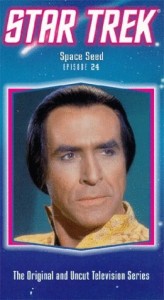Source Text: “Space Seed.” Star Trek: The Original Series. Writ. Gene L. Coon and Carey Wilber. Dir. Mark Daniels. NBC. 1967.
Entry Author: Emma Baker
Perhaps the most memorable or well-known villain of Star Trek: The Original Series, Khan Noonien Singh is a genetically engineered and selectively bred man intended to possess superhuman powers, both physical and mental. Also known as an “augment,” Khan results from an experiment enacted by several scientists on Earth during the 1990s. However, these scientists did not account for the idea that, “superior ability breeds superior ambition,” (“Space Seed”) and many of the augments began to seize control of over 40 different nations. Kirk says on the subject, “an improved breed of human. That’s what the Eugenics War was all about.” (“Space Seed”) Khan, who controlled one third of the earth, from Asia to the Middle East, was the “best of the tyrants,” under his rule there were no massacres, he did not initiate any fights. While Spock found him morally reprehensible and only deserving of scorn, many humans on board expressed an admiration of his strength and abilities while still disapproving of his actions. They consider Khan, “the best of the tyrants and the most dangerous.” (“Space Seed”) He attempts to take over the Enterprise with his augmented crew with the intention of finding a new planet to conquer and almost succeeds with the compliance of Lieutenant McGivers, a white woman, who falls in love with him. In the end, instead of bringing him to Starfleet, James T. Kirk exiles him and his crew to a planet where they can begin to colonize themselves reflecting the penal colony on Australia, Botany Bay. Later, Khan goes on to be the antagonist of The Wrath of Khan, often considered the best Star Trek movie with the cast of the original series.These “augments” were created from a variety of Earth’s ethnic groups. In the episode, “Space Seed,” Scotty says, “they’re all mixed types–Western, Mid-European, Latin, Oriental.” (“Space Seed”) On the first sight of Khan, the historian Lieutenant McGivers suggests he hails, “From the Northern India area I’d guess, probably a Sikh,” perhaps in an expression of Orientalist anxieties. Though little textual evidence points toward these augments as of a mixture of several different ethnic groups within each individual, rumors among some fan understanding suggest that Khan himself is a mixture of several races, perhaps the end result if all races were mixed. The concept revolves around the beneficial combination of several different ethnic groups to create superhumans that share the best aspects of all races and culminates in the most prominent of the augments, a man who is not white.As such, Khan’s role both challenges and maintains the status quo. A non-white person presented as the superhuman product of the genetic engineering and selective breeding remains rare even in modern day media. In the 1960s, it was arguably revolutionary. The rumor of not only the inclusion many different ethnic groups in genetic engineering but perhaps the explicit mixing also challenges a status quo concerned with historical intents of eugenics movements. Instead of the preservation of a “pure” race revolving around white supremacy, this experiment produced superhumans of all races and the potential of mixed races. Interestingly, the seeds of constructing mixed race as a herald of modernity and a post-race society are recognizable in this interpretation.

